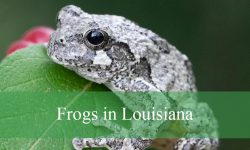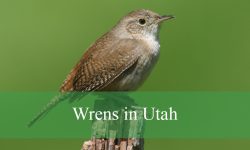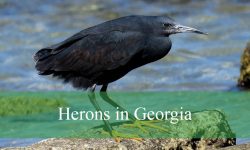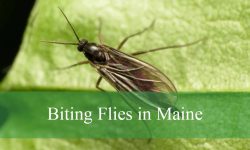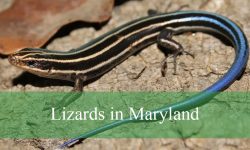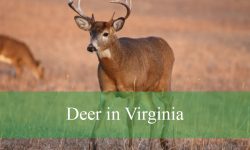Alabama is home to a rich diversity of bird species, ranging from colorful songbirds to striking raptors. Birdwatchers and nature enthusiasts can enjoy observing these birds across forests, wetlands, and suburban backyards.
From the bright red Northern Cardinal to the clever Blue Jay, each bird in Alabama displays unique behaviors and distinctive markings. Recognizing these species enhances the experience for both beginners and seasoned birdwatchers.
Exploring the Mobile-Tensaw Delta, hiking in a national forest, or setting up feeders at home provides abundant opportunities to spot and identify Alabama’s common birds. This guide covers 40 species with pictures and key identification features to help you get started.
Types of Birds Found in Alabama
Northern Cardinal
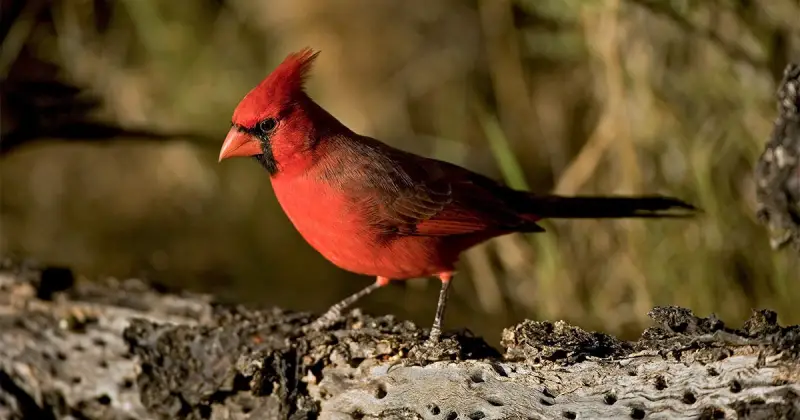
The Northern Cardinal is one of the most recognizable and beloved birds in Alabama, known for the male’s brilliant red plumage and the female’s warm brown feathers with touches of red. Both sexes have a distinctive crest on the head and a strong orange beak that stands out. They are year-round residents in Alabama, often spotted in backyards, woodlands, and parks.
These birds are famous for their melodic whistles, which are sung by both males and females. They are not shy around humans and frequently visit feeders stocked with sunflower seeds. During the breeding season, cardinals are protective of their territories and can be seen chasing away rivals or even their own reflections.
Northern Cardinals thrive in a wide range of habitats, from suburban neighborhoods to forest edges. Their adaptability makes them one of the most common birds in Alabama. Because they are non-migratory, you can enjoy their presence all year, especially as a splash of color against the greenery in summer or bare branches in winter.
Blue Jay
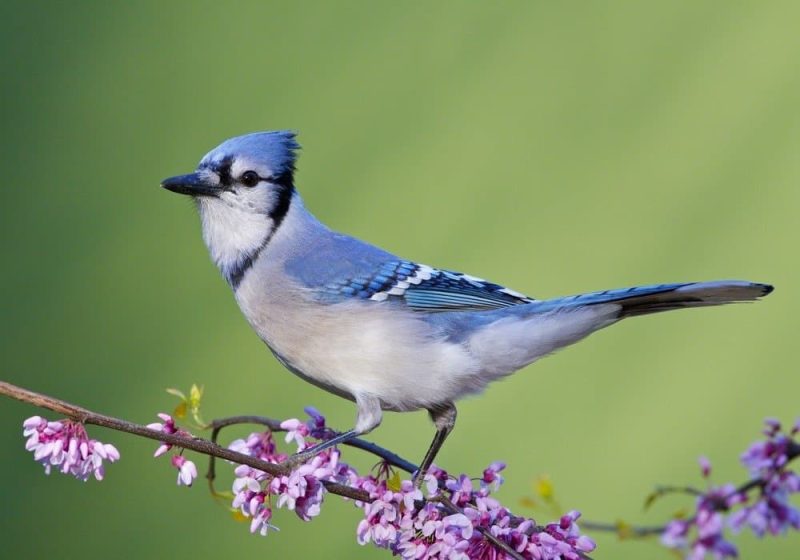
The Blue Jay is a striking bird with bright blue feathers, a white chest, and a bold crest on its head. These intelligent birds are common in Alabama’s forests, suburbs, and parks. They are often noticed for their loud calls and bold behavior, making them one of the more conspicuous species in the region.
Blue Jays are highly social and sometimes mimic the calls of hawks to warn or confuse other birds. They are known for caching acorns and other food, playing an important role in seed dispersal across Alabama’s landscapes. At feeders, they often dominate smaller birds with their assertive personalities.
They prefer mixed woodlands but adapt well to human presence, often nesting in residential areas. Their vibrant blue plumage is not due to pigment but rather the way light reflects off the microscopic structure of their feathers. In Alabama, Blue Jays remain throughout the year, bringing energy and sound to any habitat they occupy.
American Robin
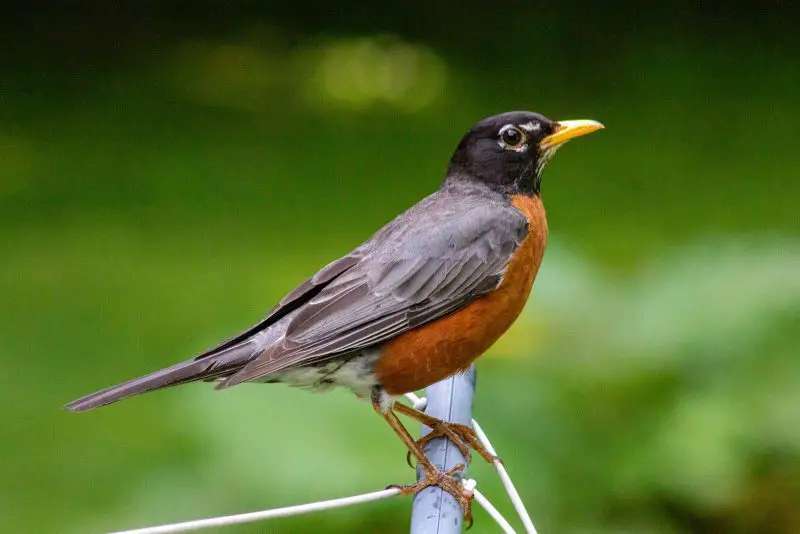
The American Robin is a familiar sight across Alabama, especially in spring and summer when they are often seen tugging earthworms from the ground. Recognizable by their reddish-orange breast, dark head, and cheerful song, robins are often among the first birds people learn to identify.
They are early harbingers of spring, though many stay in Alabama year-round. During the breeding season, robins are busy building nests out of grass and mud in trees, shrubs, or even on human structures. Their melodious morning song is a staple of Alabama’s soundscape.
American Robins thrive in lawns, fields, and woodland edges, making them highly adaptable to both urban and rural environments. In winter, they gather in flocks and feed on berries and fruits. Their adaptability and widespread presence ensure that robins remain one of the most commonly observed birds across Alabama.
Eastern Bluebird
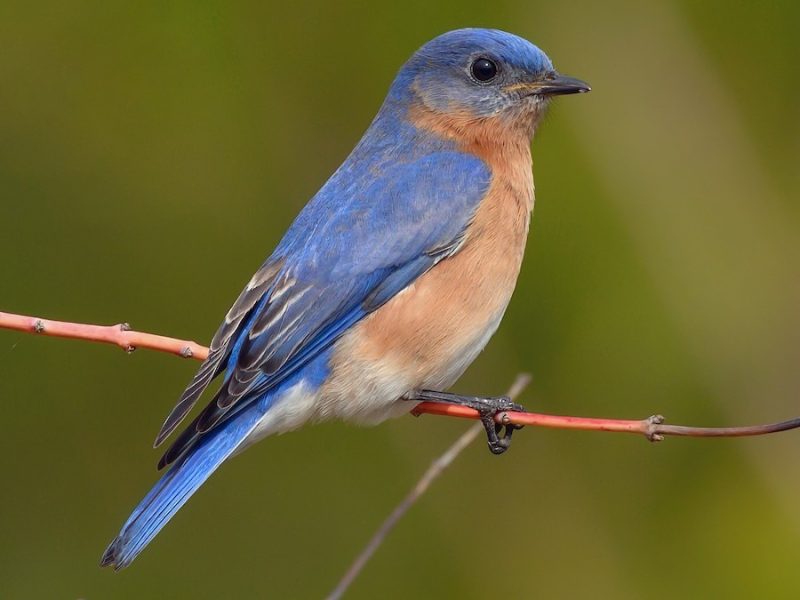
The Eastern Bluebird is a small, colorful bird that is cherished in Alabama for its brilliant blue plumage and rusty-red breast. Males are especially vibrant, while females display more muted shades. Their cheerful presence makes them a favorite among birdwatchers, especially in open fields and meadows.
Eastern Bluebirds are cavity-nesting birds and readily use birdhouses, which has helped their population rebound after declines caused by competition with invasive species like starlings and house sparrows. They feed primarily on insects during the warmer months and switch to berries in winter.
These birds prefer open country with scattered trees, such as pastures and forest edges. In Alabama, they are year-round residents and are often seen perched on fences or wires, scanning the ground for food. Their gentle song and stunning coloration make them a symbol of happiness and renewal.
Carolina Chickadee
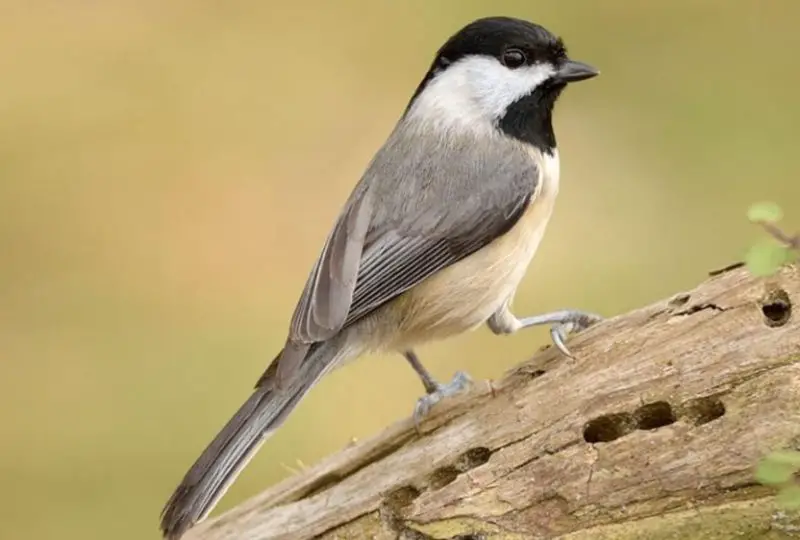
The Carolina Chickadee is a small, energetic bird that is common throughout Alabama. It has a black cap and bib, white cheeks, and soft gray feathers, making it easy to identify. Despite its small size, this bird is bold and often approaches feeders or explores wooded backyards.
Their signature “chick-a-dee-dee-dee” call gives them their name and makes them easy to recognize even without sighting them. Carolina Chickadees are curious, active, and often travel in small flocks, especially during the winter months when they mix with other songbirds.
They thrive in deciduous and mixed forests, as well as suburban yards with trees and shrubs. Because of their year-round presence in Alabama, they bring activity and life to feeders and gardens in every season. Their adaptability and lively nature make them one of the state’s most familiar songbirds.
Tufted Titmouse
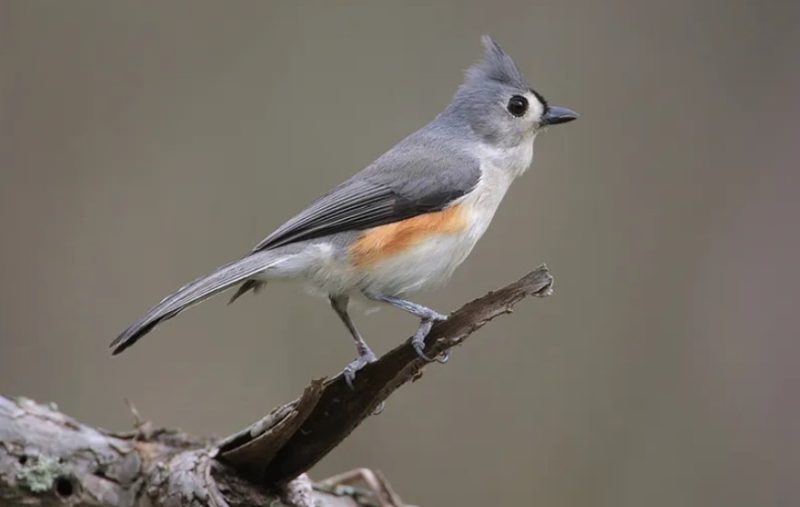
The Tufted Titmouse is a small gray songbird with a distinctive crest on its head and a large black eye that gives it a curious expression. Its pale underparts contrast with its gray back, and it often shows a wash of rusty orange along its flanks. This bird is a common visitor to feeders in Alabama, especially when sunflower seeds or suet are offered.
Known for their sharp “peter-peter-peter” call, Tufted Titmice are active and inquisitive birds. They often travel with mixed flocks of chickadees, nuthatches, and woodpeckers, especially in the cooler months. Their behavior includes caching food for later use, which helps them survive through the winter.
They thrive in deciduous and mixed forests, as well as suburban gardens with mature trees. Tufted Titmice are non-migratory, meaning they can be found in Alabama year-round. Their playful antics and distinctive crest make them easy to spot and enjoyable to watch in both natural and backyard settings.
Carolina Wren
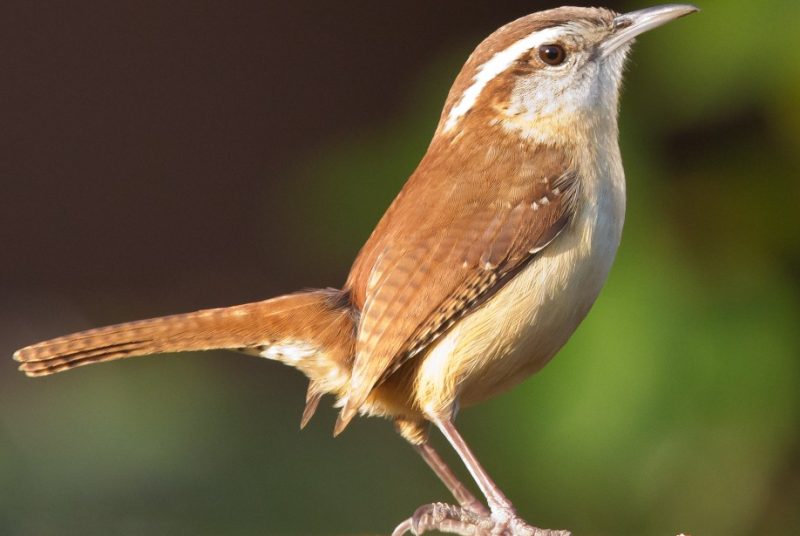
The Carolina Wren is a small, chunky bird with a rich reddish-brown back, buffy underparts, and a bold white eyebrow stripe. Despite its small size, it has one of the loudest voices of any backyard bird, filling Alabama’s woodlands and neighborhoods with cheerful songs year-round.
These wrens are often seen flitting through shrubs, brush piles, or low vegetation as they search for insects and spiders. They are curious and bold, frequently exploring porches, garages, or sheds. Carolina Wrens are also known for their messy dome-shaped nests, often built in unusual places such as flowerpots or mailboxes.
In Alabama, they are permanent residents, preferring wooded areas, thickets, and suburban yards. Their adaptability and strong presence in both rural and urban landscapes make them one of the most common and beloved birds across the state.
Northern Mockingbird
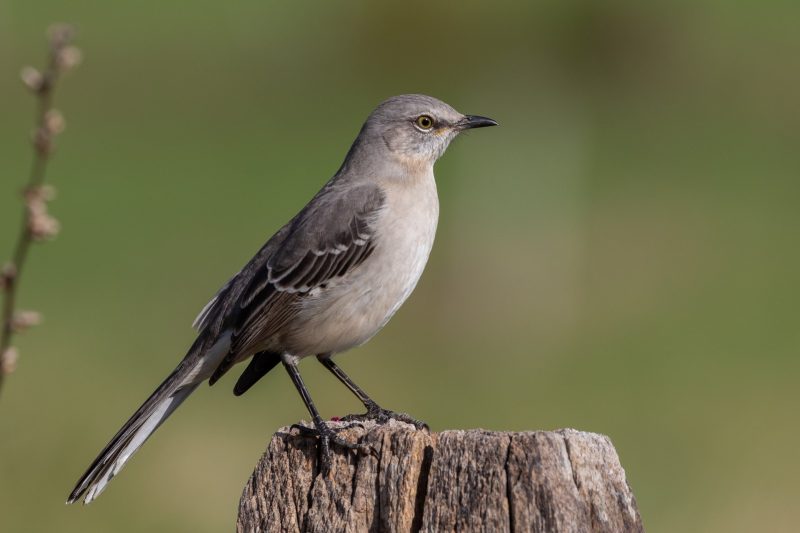
The Northern Mockingbird is a medium-sized gray bird with white wing patches and a long tail. It is best known for its extraordinary vocal ability, capable of imitating the songs of other birds, frogs, and even mechanical sounds. These birds are highly visible and are often seen perched on fences, rooftops, or treetops across Alabama.
Mockingbirds are fiercely territorial, especially during the breeding season. They will aggressively defend their nests against much larger animals, including cats and crows. Their displays often include flashing their wings in a bold manner, which may help startle insects.
They thrive in open habitats, suburban neighborhoods, and forest edges. Northern Mockingbirds are year-round residents in Alabama, and their versatile songs bring constant music to gardens and city streets alike. Their adaptability has helped them become one of the state’s most iconic birds.
Mourning Dove
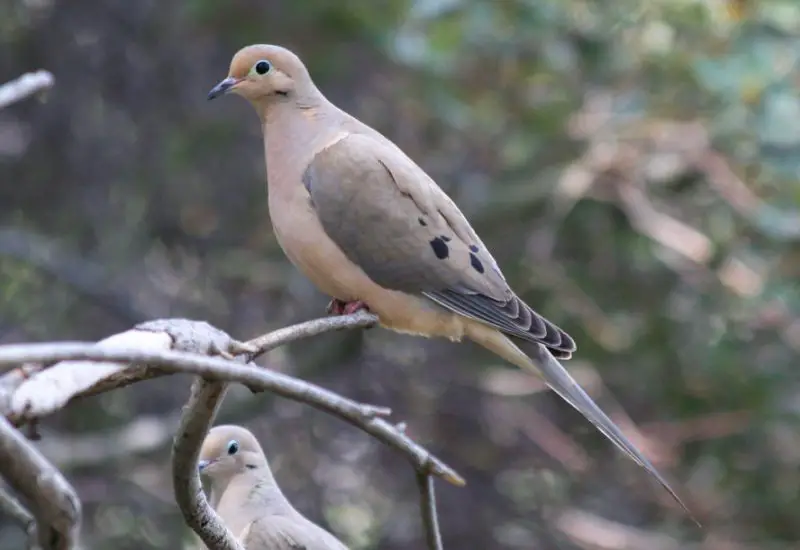
The Mourning Dove is a graceful, slender bird with soft gray-brown plumage, black wing spots, and a long pointed tail. Its gentle cooing calls are a familiar sound across Alabama, especially in the early morning and evening. These doves are often seen perched on telephone wires, rooftops, or feeding on the ground beneath bird feeders.
They are fast and agile fliers, capable of reaching speeds up to 55 miles per hour. Mourning Doves primarily eat seeds, and their diet includes grains, grasses, and cultivated crops. At feeders, they prefer cracked corn, millet, or sunflower seeds.
In Alabama, Mourning Doves are present year-round and nest multiple times during the breeding season, raising several broods each year. They are common in open fields, farmlands, and suburban areas, where their soothing calls and graceful flight patterns make them a welcome presence.
Red-bellied Woodpecker
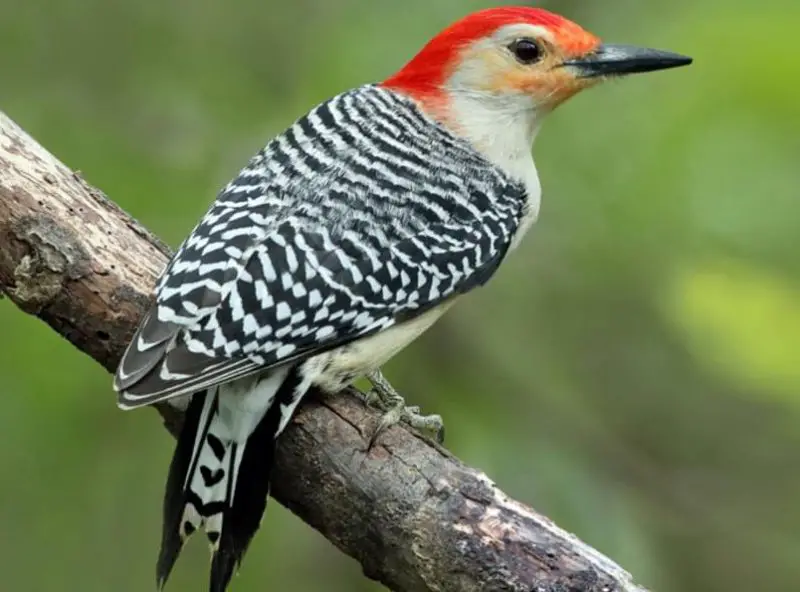
The Red-bellied Woodpecker is a striking bird with black-and-white barred wings and a pale belly that often shows a faint reddish tinge. The most noticeable feature is the bright red cap that extends from the bill to the nape in males and only on the nape in females. This woodpecker is a frequent visitor to feeders in Alabama, especially when suet or peanuts are available.
They are known for their loud, rolling “churr” calls and their habit of drumming on trees or even metal objects. Red-bellied Woodpeckers are skilled foragers, often climbing tree trunks and branches in search of insects, nuts, and fruits. They also store food in tree crevices to eat later.
In Alabama, they are found year-round in forests, woodlots, and residential areas with mature trees. Their striking appearance, bold behavior, and adaptability make them one of the most recognized and appreciated woodpeckers in the state.
Downy Woodpecker
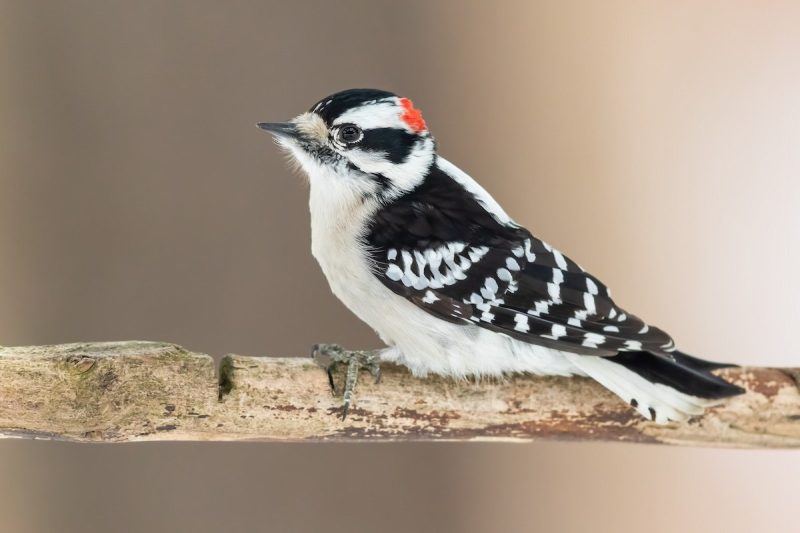
The Downy Woodpecker is the smallest woodpecker in Alabama, easily recognized by its black-and-white checkered wings and white underside. Males have a small red patch on the back of the head, while females lack this marking. Despite their small size, they are energetic and often visit backyard feeders, especially for suet and sunflower seeds.
They are skilled climbers, moving up tree trunks and branches as they probe for insects hidden in the bark. Their sharp tapping can be heard year-round as they forage or communicate with mates. Downy Woodpeckers also take advantage of weedy fields and gardens, feeding on seeds and small fruits.
In Alabama, they thrive in forests, orchards, and suburban areas with mature trees. Their adaptability to both wild and urban habitats makes them one of the most common and approachable woodpeckers in the region.
Pileated Woodpecker
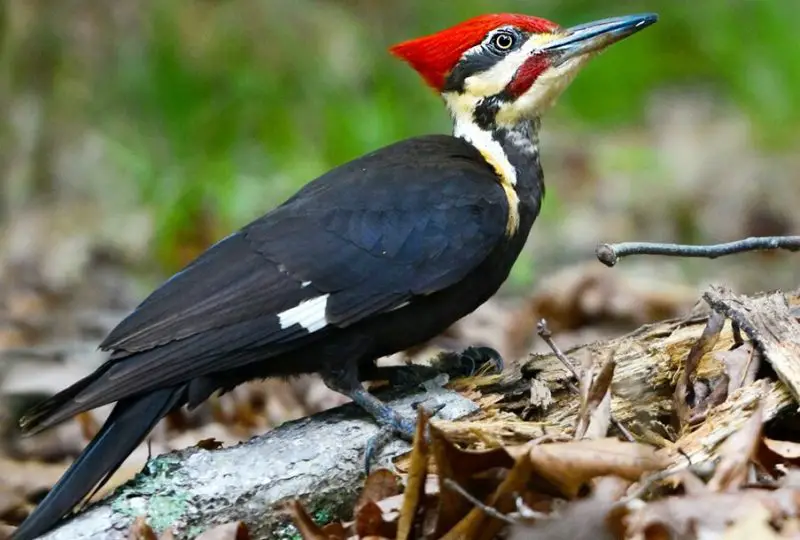
The Pileated Woodpecker is the largest woodpecker in Alabama and one of the most impressive birds in North America. It is recognized by its striking black body, bold white stripes along the neck, and a brilliant red crest. Its loud, ringing calls and powerful drumming are distinctive sounds in Alabama’s forests.
This bird is known for chiseling large rectangular holes in trees in search of carpenter ants and beetle larvae. These excavations also provide shelter for other birds and mammals, making the Pileated Woodpecker an important part of the ecosystem. Their size and strong flight make them a dramatic sight when seen gliding between trees.
They prefer mature forests with plenty of dead or decaying trees but can also be found in wooded suburbs. In Alabama, they are permanent residents, and their presence is a reminder of the state’s rich woodland habitats.
American Goldfinch
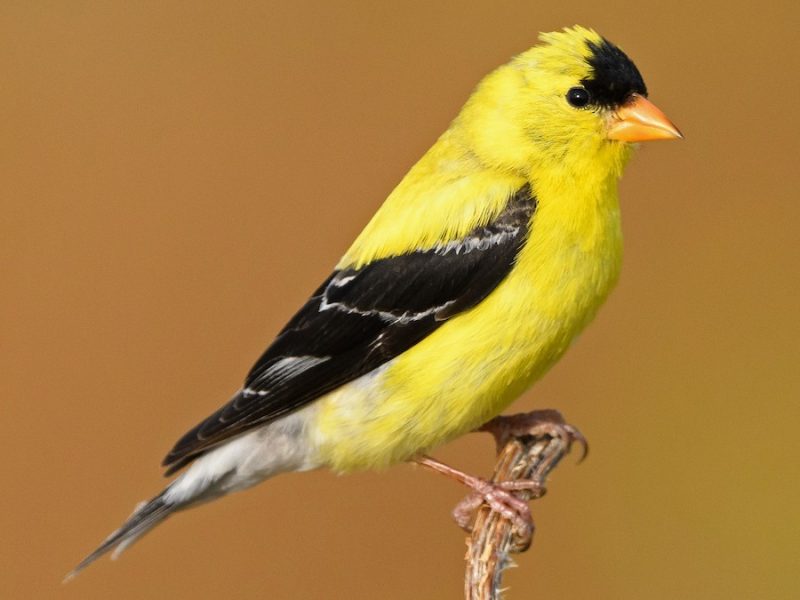
The American Goldfinch is a small, lively bird known for its bright yellow plumage during the breeding season. Males turn a vibrant golden yellow with black wings and a black cap in summer, while females are a more subdued olive-yellow. In winter, both sexes take on a duller brown color but still retain their distinctive wing patterns.
These finches are frequent visitors to feeders, especially when thistle (nyjer) seed is available. They are acrobatic feeders, often clinging to seed heads or hanging upside down to reach food. Their cheerful, bouncy flight pattern and sweet, twittering calls make them easy to recognize.
In Alabama, American Goldfinches are present year-round, although their numbers increase in winter as northern birds migrate south. They prefer weedy fields, gardens, and forest edges where seeds are abundant, making them a common and colorful sight in many habitats.
House Finch
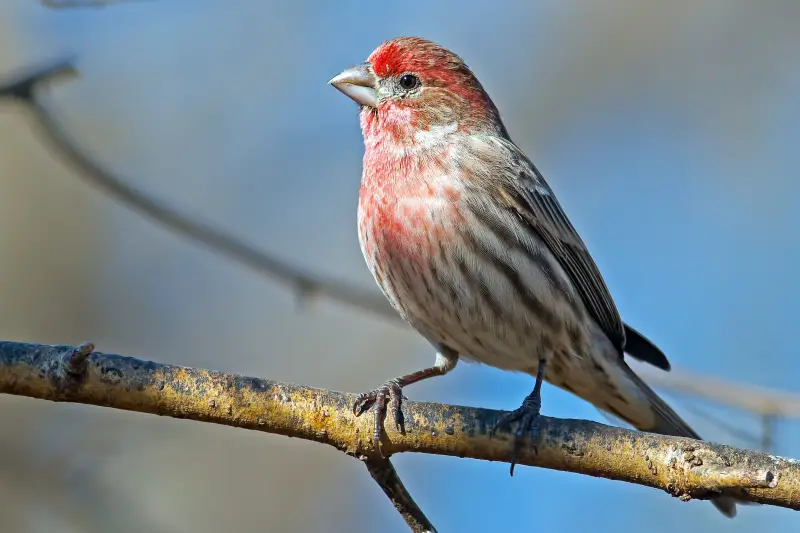
The House Finch is a medium-sized finch with a cheerful song and streaked brown plumage. Males are distinguished by their red foreheads, throats, and breasts, while females are more uniformly brown and streaked. Their adaptability has made them one of the most common backyard birds in Alabama.
House Finches are social birds that often gather in flocks, especially around feeders stocked with sunflower seeds. They also feed on a variety of fruits, buds, and seeds. Their lively warbling song adds charm to gardens and neighborhoods across the state.
They thrive in urban and suburban areas as well as open woodlands and farmland. In Alabama, they are present year-round and are often seen perched on wires, rooftops, or shrubs. Their bold nature and colorful appearance make them a favorite among birdwatchers.
Eastern Towhee
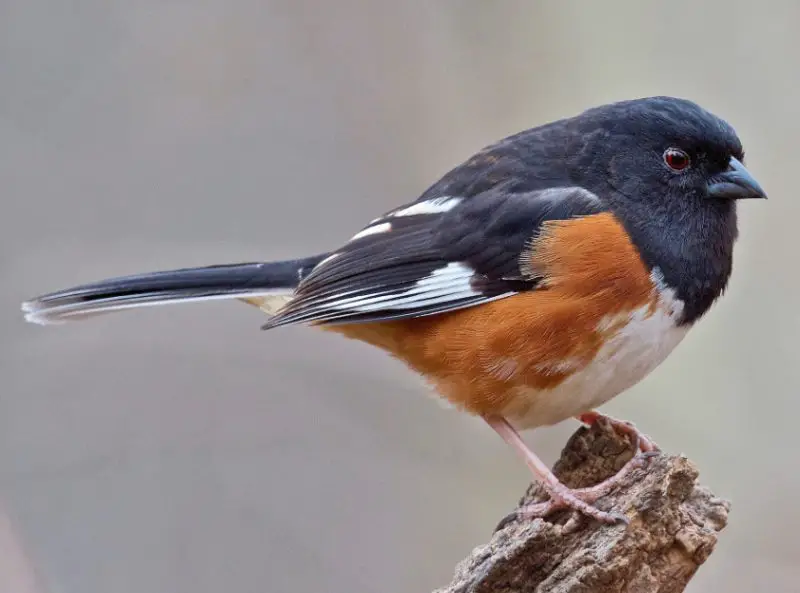
The Eastern Towhee is a striking songbird with bold black, white, and rusty-orange coloring. Males have jet-black upperparts, while females are a rich brown. Both sexes share the same rufous sides and white bellies, making them easy to spot when they scratch through leaves on the ground.
Their call sounds like “drink-your-tea,” a phrase birdwatchers often use to remember their song. Eastern Towhees forage mostly on the forest floor, using both feet to scratch away leaf litter in search of seeds and insects. Their foraging behavior often makes them noticeable even when hidden in dense brush.
Towhees prefer shrubby habitats, forest edges, and overgrown fields. In Alabama, they are common year-round residents, bringing color and sound to woodland borders and suburban yards. Their bold patterns and lively songs make them one of the state’s more eye-catching ground-feeding birds.
Brown Thrasher
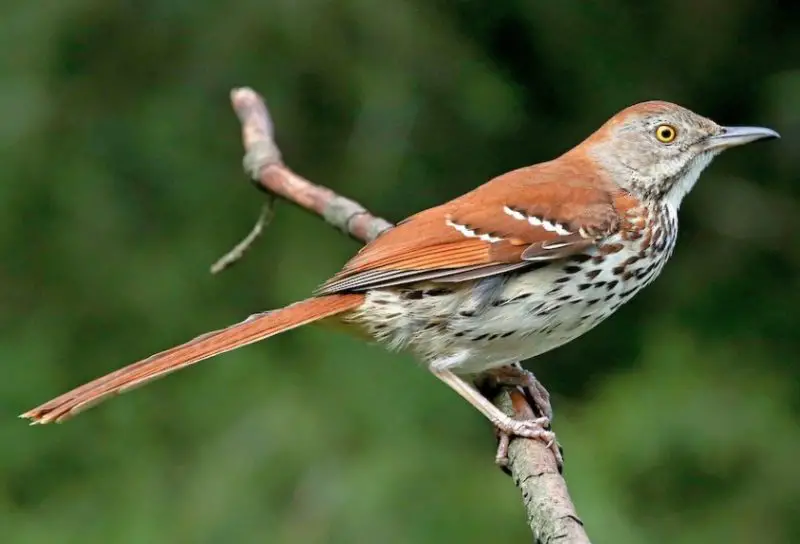
The Brown Thrasher is a large, slender songbird with a long tail and rich reddish-brown plumage above and heavily streaked underparts below. Its bright yellow eyes give it a sharp, alert look. This bird is often secretive, staying hidden in thickets and shrubs, but its size and striking plumage make it unmistakable when spotted.
Brown Thrashers are exceptional mimics, with a repertoire of over a thousand song variations, making them one of the most skilled singers in Alabama. They are usually heard before they are seen, delivering a series of repeated phrases from a hidden perch. Their strong curved bill allows them to forage through leaf litter for insects, fruits, and seeds.
In Alabama, Brown Thrashers are permanent residents, preferring brushy habitats, forest edges, and suburban gardens. Their elusive nature means they are not as commonly observed at feeders, but they remain widespread and important contributors to the state’s birdlife.
Song Sparrow
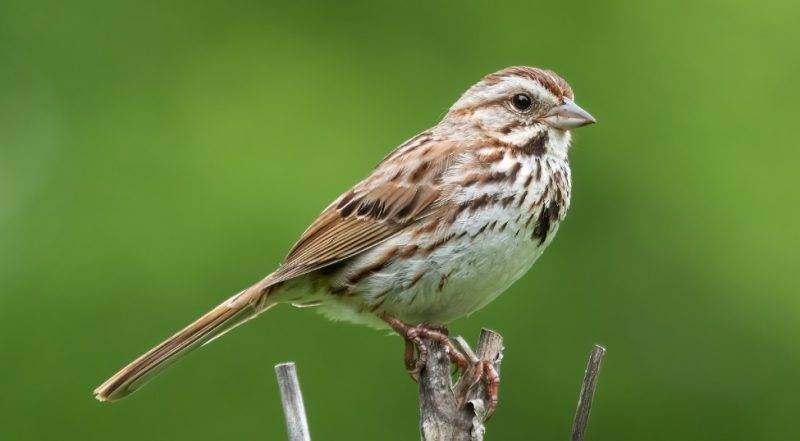
The Song Sparrow is a medium-sized bird with streaky brown plumage and a distinct dark spot on its chest. Although not as brightly colored as some other songbirds, its sweet and varied song makes it easy to recognize in the field. These birds often perch in plain sight, singing loudly to declare territory.
They are ground foragers, scratching through grasses and soil to find seeds and insects. Song Sparrows adapt well to human presence and are often seen in gardens, farmlands, and marshy areas across Alabama. Their streaked appearance provides excellent camouflage in grassy habitats.
In Alabama, they are common winter visitors, with some populations present year-round in the northern parts of the state. Their adaptability to a wide range of habitats makes them a familiar sight and sound for birdwatchers.
Chipping Sparrow
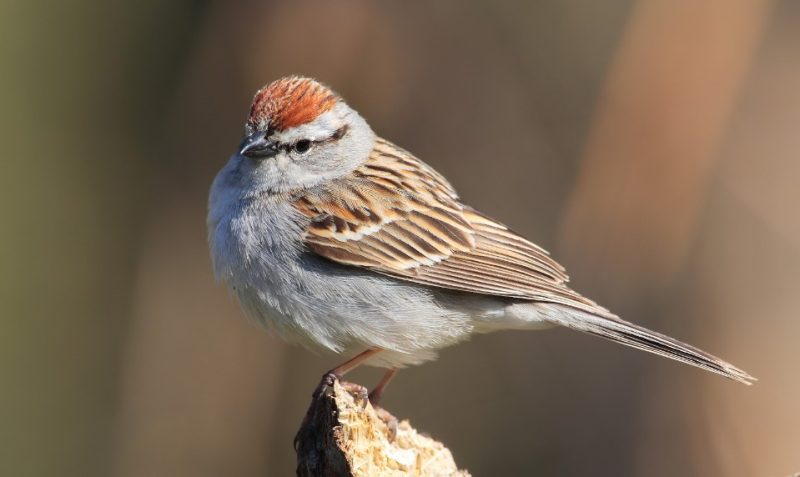
The Chipping Sparrow is a small, slender bird with a distinctive rusty-red cap, a black eye line, and a grayish-white underside. In breeding season, their crisp markings make them easy to identify, while in winter, they appear duller but still retain their slim, active look.
These sparrows are highly social and often gather in flocks, especially outside the breeding season. Their dry, trilling song is a common sound in open woodlands, grassy yards, and suburban neighborhoods. They primarily feed on seeds but also take insects during summer.
In Alabama, Chipping Sparrows are year-round residents, though their numbers swell in winter as northern birds migrate south. They are particularly common around bird feeders, where they often form part of mixed flocks with other sparrows and finches.
White-throated Sparrow
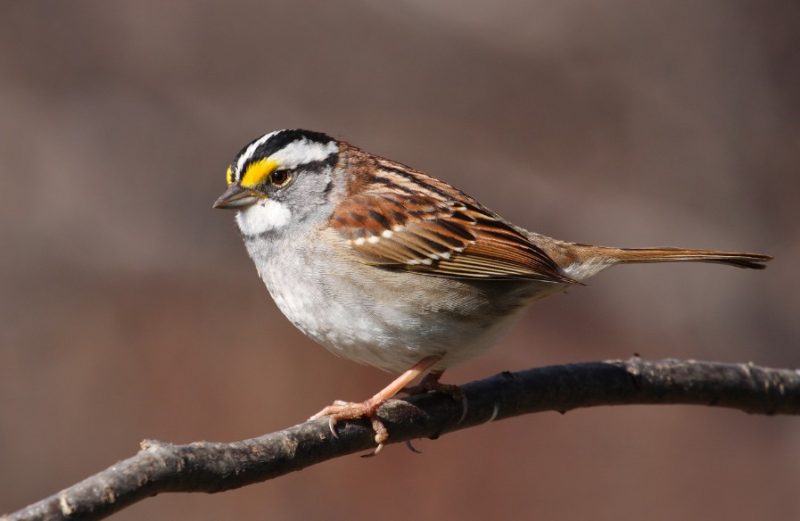
The White-throated Sparrow is a medium-sized sparrow easily recognized by its bold white throat patch, striped head, and bright yellow lores (the area in front of the eyes). There are two head color variations: white-striped and tan-striped, both common in Alabama.
Their clear, whistled song, often described as “Old Sam Peabody, Peabody, Peabody,” is a familiar sound in wooded areas during migration and winter months. White-throated Sparrows forage on the ground, scratching through leaf litter for seeds, fruits, and insects.
In Alabama, they are primarily winter visitors, arriving in large numbers during the colder months and departing northward to breed in summer. They prefer brushy habitats, forest edges, and residential areas with dense cover. Their striking markings and sweet song make them a favorite among winter birdwatchers.
Eastern Phoebe
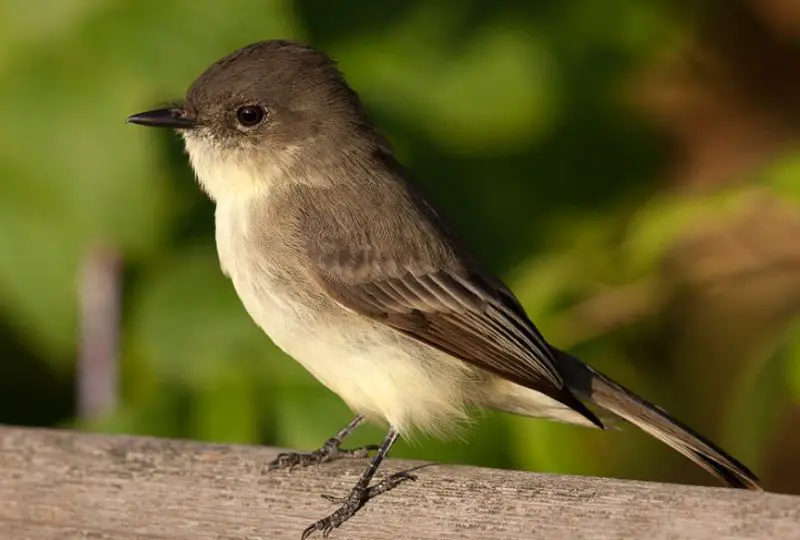
The Eastern Phoebe is a small flycatcher with a plain gray-brown back, pale underside, and a slightly darker head. Its lack of bold markings makes it a modest-looking bird, but it is easily recognized by its habit of wagging its tail up and down when perched. In Alabama, this bird is a familiar sight around farms, woodlands, and suburban yards.
Eastern Phoebes are excellent insect hunters, often seen darting out from a perch to snatch flies, beetles, or moths in midair. They also eat berries during colder months. Their simple “fee-bee” call is one of the earliest songs of spring, often heard as soon as the weather warms.
In Alabama, they are year-round residents and frequently nest near human structures such as bridges, barns, and porches. Their adaptability to human presence and reliable return each year make them a welcome bird across the state.
Eastern Kingbird
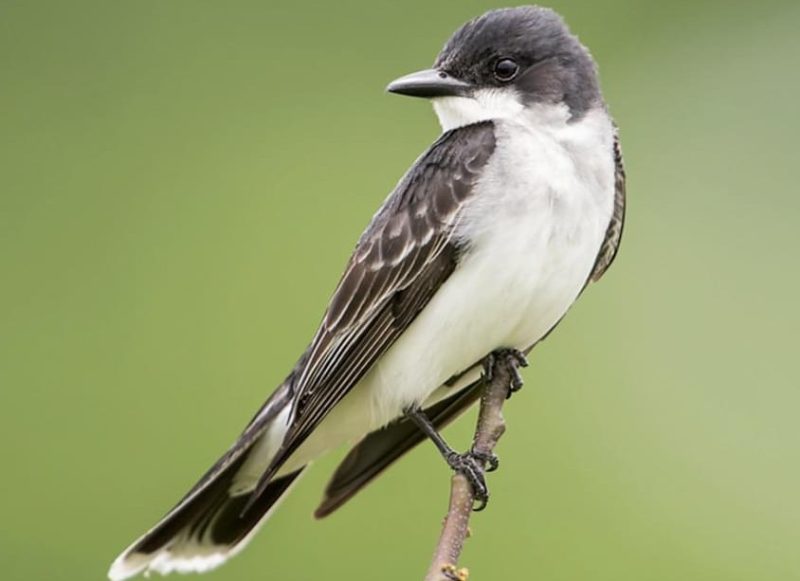
The Eastern Kingbird is a bold, medium-sized flycatcher with dark gray upperparts, a white underside, and a distinctive white-tipped tail. Its upright posture and aggressive behavior make it stand out among other birds in Alabama. They are often seen perched in open areas, scanning for flying insects.
True to their name, kingbirds fiercely defend their territories. They are known to chase away much larger birds, including hawks and crows, when they come too close. Their feeding strategy involves quick flights from a perch to catch insects in the air, returning swiftly to the same spot.
In Alabama, Eastern Kingbirds are summer residents, arriving in spring to breed and departing in fall for South America. They prefer open habitats such as fields, farmlands, and forest edges, where their bold nature and sharp calls make them easy to notice.
Great Crested Flycatcher
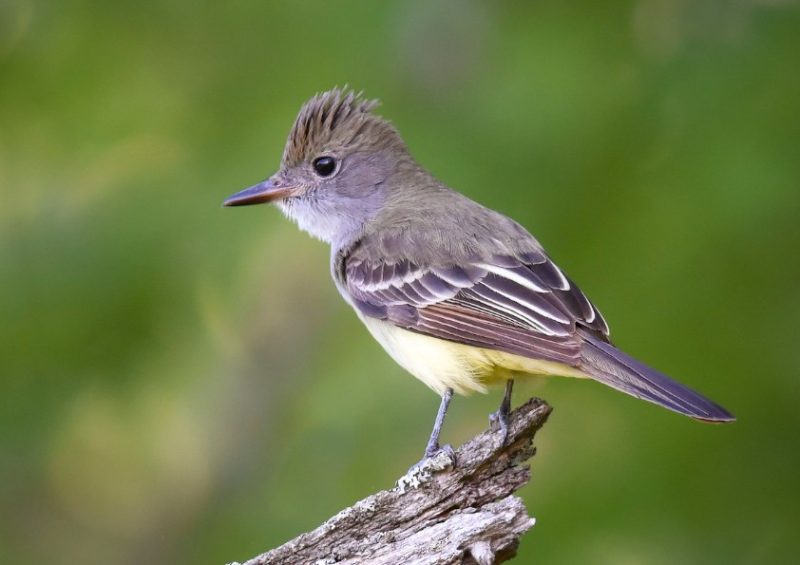
The Great Crested Flycatcher is a striking flycatcher with olive-brown upperparts, a gray throat, and a bright yellow belly. It also has a noticeable crest and rufous tones in its wings and tail. Although not as commonly seen as some other backyard birds, its loud “wheep” call often reveals its presence in Alabama’s woodlands.
This bird is known for its unusual nesting behavior. Great Crested Flycatchers frequently use tree cavities and often line their nests with snake skins or other unique materials. They feed on large insects, such as grasshoppers and dragonflies, and also eat fruits during the summer.
In Alabama, they are summer residents, breeding in forests, parks, and wooded suburbs. Their striking appearance, distinctive calls, and curious nesting habits make them an interesting species for birdwatchers.
Barn Swallow
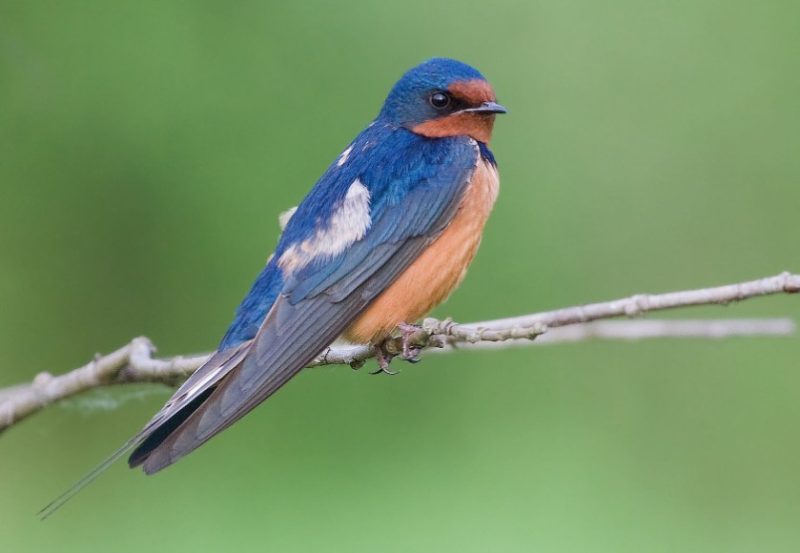
The Barn Swallow is one of the most graceful fliers in Alabama, with long pointed wings, a deeply forked tail, and glossy blue upperparts. Its underparts are a warm buff or reddish color, making it one of the most elegant swallows in North America.
These swallows feed almost entirely on insects, catching them in flight with incredible agility. They are often seen swooping low over fields, lakes, or open pastures. True to their name, they frequently build mud nests on barns, bridges, and other man-made structures, making them familiar companions in rural Alabama.
Barn Swallows are summer residents in Alabama, migrating to Central and South America for the winter. Their graceful flight and cheerful twittering calls make them a welcome sign of warmer months.
Purple Martin
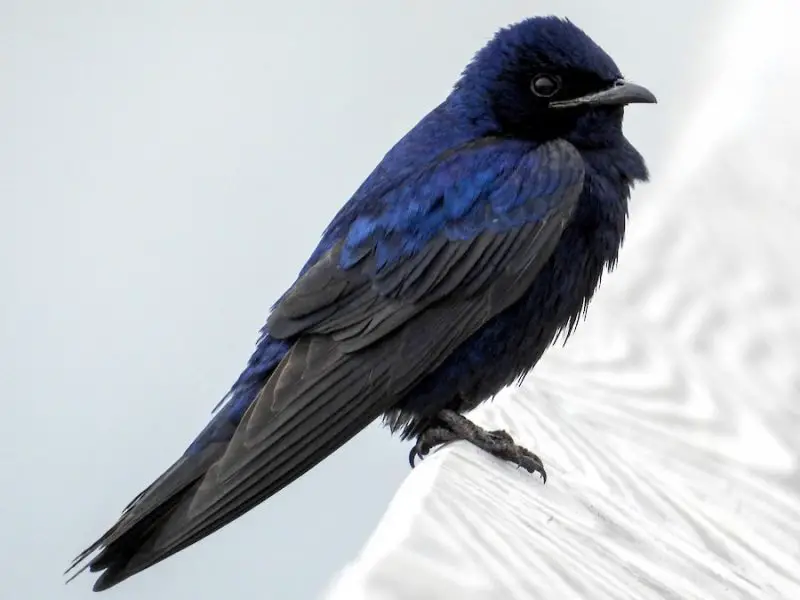
The Purple Martin is the largest swallow in North America and a beloved bird in Alabama, where many people provide special houses to attract them. Adult males are a glossy dark blue-black color, while females and young birds are paler with lighter underparts. Their acrobatic flight patterns and pleasant calls make them favorites among bird enthusiasts.
Purple Martins feed exclusively on flying insects, including mosquitoes, flies, and beetles. They are highly social birds and often nest in colonies, particularly in human-provided birdhouses or gourds. Their dependence on human nesting structures in the eastern United States makes them unique among swallows.
In Alabama, Purple Martins are summer visitors, arriving in early spring and leaving by late summer for South America. Their arrival is celebrated by many, as they are considered harbingers of spring and symbols of good luck.
Tree Swallow
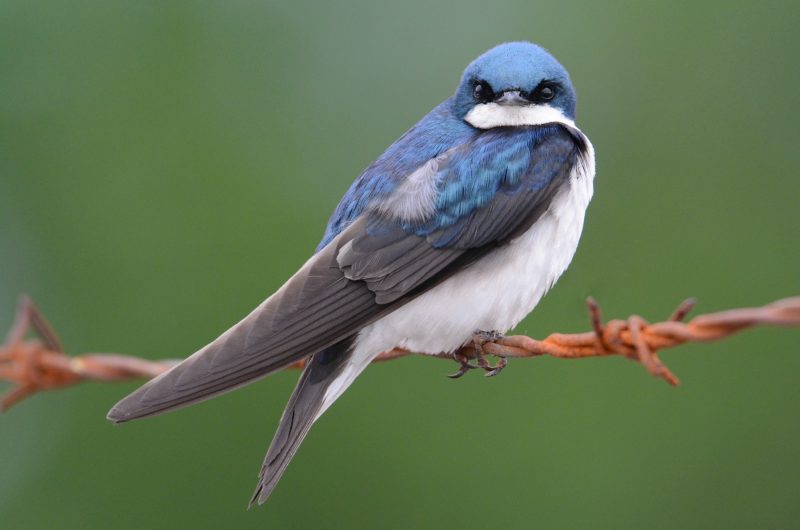
The Tree Swallow is a sleek, graceful bird with iridescent blue-green upperparts and clean white underparts. Its streamlined body and pointed wings make it one of the most elegant aerial insect hunters in Alabama. These birds are often seen gliding smoothly over lakes, ponds, and open fields.
They feed almost entirely on flying insects, catching them with incredible precision while in flight. During colder weather when insects are scarce, Tree Swallows can switch to eating berries, which helps them survive conditions that challenge other insect-eating birds. Their twittering calls add to the lively soundscape of wetlands and open areas.
In Alabama, Tree Swallows are most common during migration, though some remain to breed in the northern parts of the state. They nest in tree cavities or birdhouses, making them accessible for birdwatchers who provide suitable housing.
Red-winged Blackbird
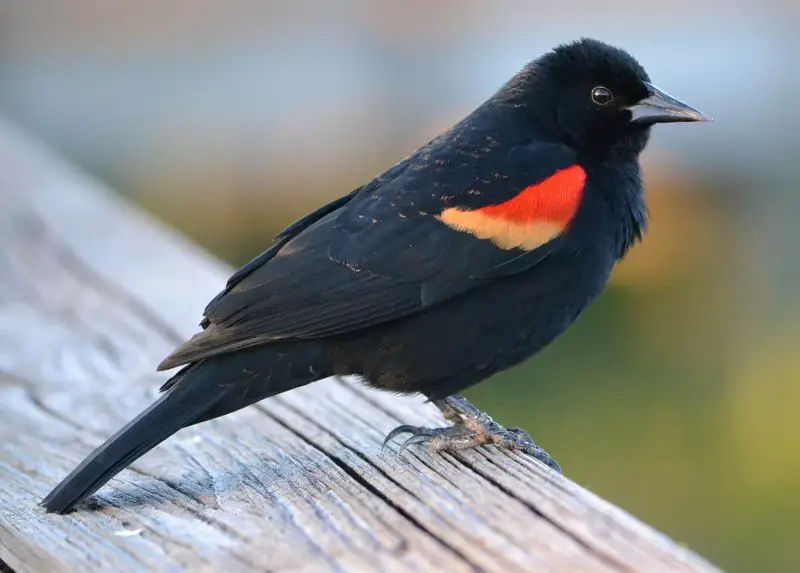
The Red-winged Blackbird is one of the most striking and widespread birds in Alabama. Males are glossy black with bold red and yellow shoulder patches, while females are streaked brown and resemble large sparrows. Their distinctive appearance makes them easy to identify in fields and marshes.
These birds are highly territorial during breeding season, with males often perching on cattails or fence posts to display their colors and sing their familiar “conk-la-ree” call. They feed mainly on seeds and insects, often foraging in large flocks during fall and winter.
In Alabama, Red-winged Blackbirds are year-round residents, thriving in wetlands, farmland, and suburban areas. Their bold calls and flashy displays make them one of the most noticeable and memorable birds in the state.
Common Grackle
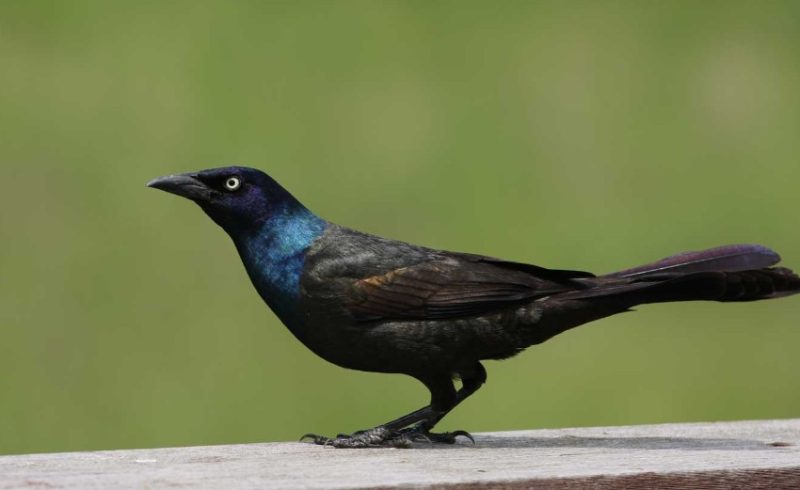
The Common Grackle is a large blackbird with a glossy, iridescent sheen that shines purple, green, or bronze in the sunlight. Its long tail and piercing yellow eyes give it a distinctive, somewhat intimidating look. These birds often gather in large flocks, creating a noisy presence in both rural and urban settings.
Grackles are opportunistic feeders, consuming insects, seeds, grains, and even small animals. They are also known to raid bird feeders and agricultural fields, sometimes causing conflicts with farmers. Their loud, creaky calls and bold behavior make them stand out among mixed flocks of blackbirds.
In Alabama, Common Grackles are found year-round in a variety of habitats, including fields, forests, towns, and marshes. Their adaptability and strong presence ensure they remain a familiar sight across the state.
European Starling
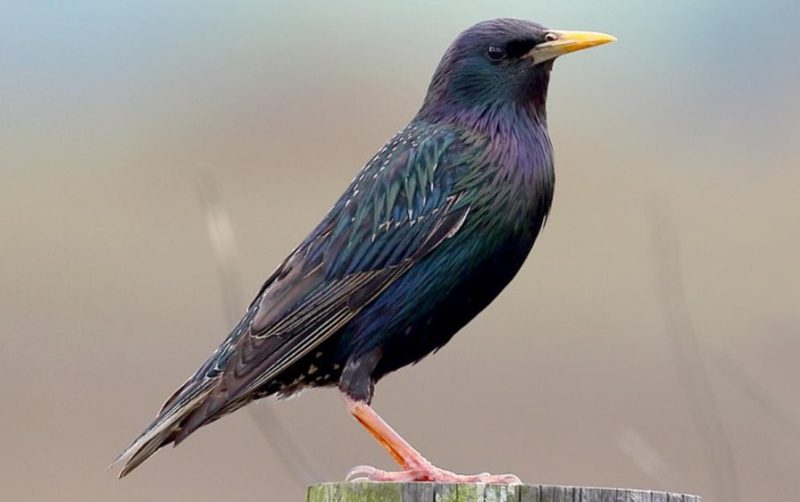
The European Starling is an introduced species that has become widespread throughout Alabama. These medium-sized birds have glossy black plumage with iridescent purple and green tones, speckled with white during the winter months. Their short tails and pointed wings give them a distinctive, triangular flight silhouette.
Starlings are highly social and often gather in large, noisy flocks. They are excellent mimics, capable of copying the songs of other birds, mechanical noises, and even human sounds. Their murmurations—massive, swirling flocks moving in unison—are among the most spectacular sights in the bird world.
In Alabama, European Starlings thrive in both rural and urban environments. They nest in cavities and can compete aggressively with native species for nesting space. Despite being invasive, they remain a common and unmistakable part of Alabama’s bird population.
American Crow
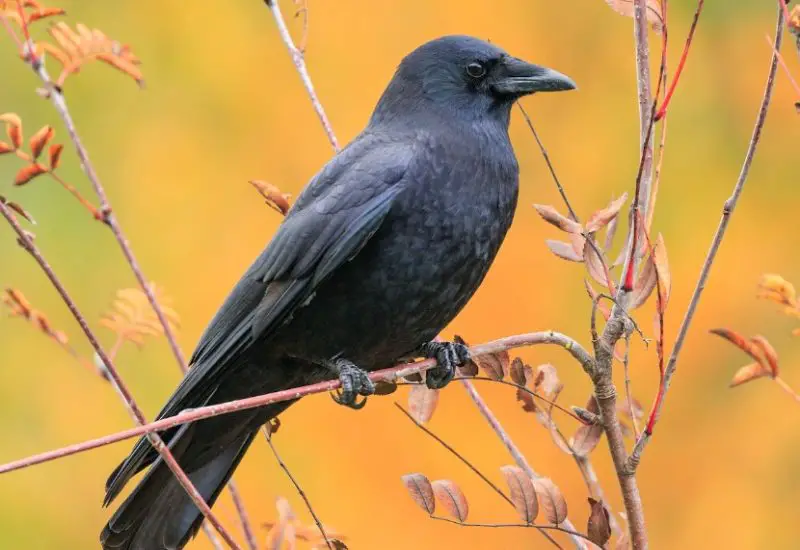
The American Crow is a large, all-black bird with a stout bill and strong, broad wings. It is highly intelligent, known for problem-solving abilities and complex social behaviors. Crows are a familiar sight across Alabama, frequently seen in fields, woodlands, and urban areas.
They are omnivorous, feeding on everything from insects and small animals to grains, fruits, and human scraps. Their loud, cawing calls are unmistakable, often serving as a communication method within flocks or as a warning to other wildlife. Crows are also known for using tools and caching food for later use.
In Alabama, American Crows are year-round residents, often forming large communal roosts in the evenings. Their adaptability and intelligence make them one of the most common and resourceful birds in the state.
Fish Crow
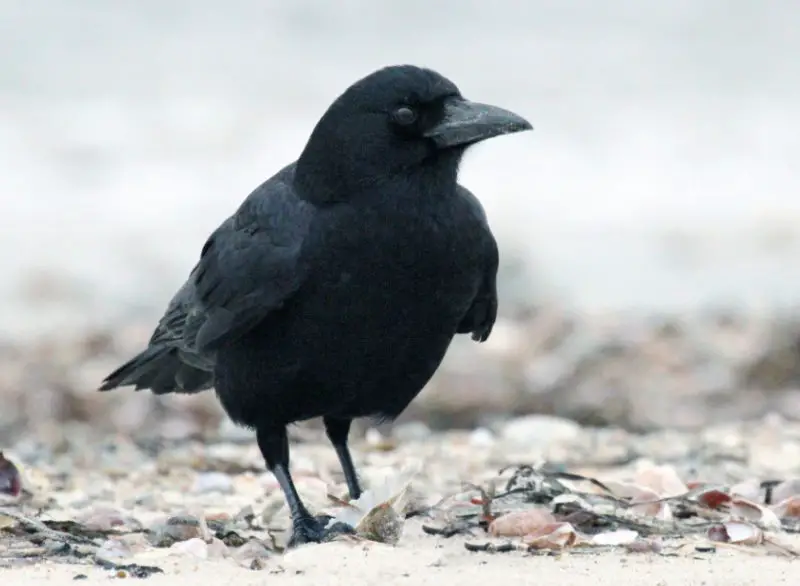
The Fish Crow is slightly smaller than the American Crow and is often recognized by its nasal, “nyuh-uh” call. Its plumage is glossy black, similar to the American Crow, which can make field identification challenging without listening to its distinctive voice. Fish Crows are commonly found near water in Alabama, including rivers, marshes, and coastal areas.
They are opportunistic feeders, consuming fish, crustaceans, insects, and human food scraps. Fish Crows are social birds, often seen in loose flocks with American Crows or other water-associated birds. Their adaptability allows them to thrive in urban and suburban areas as well.
In Alabama, they are resident birds, frequenting both natural and man-made habitats near water. Their presence contributes to the diverse blackbird populations found across the state.
Turkey Vulture
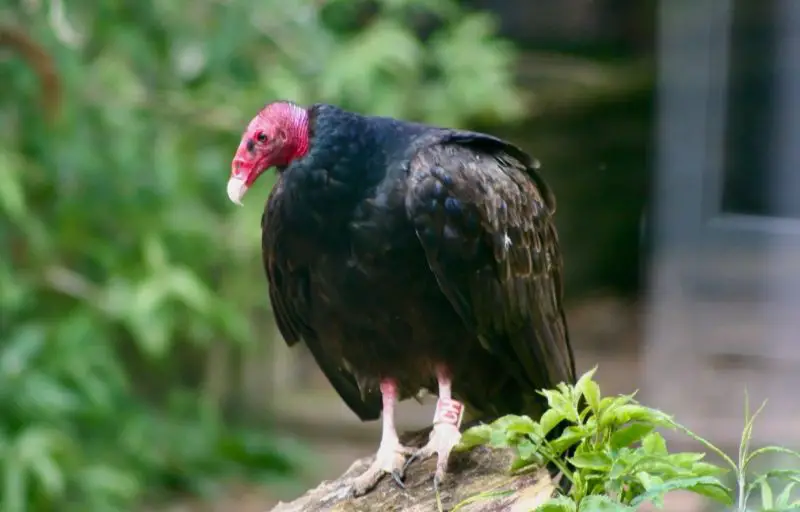
The Turkey Vulture is a large bird of prey with dark brown to black plumage and a bare red head. Its broad wings and soaring flight make it highly visible in Alabama’s skies. They are scavengers, feeding primarily on carrion, and play an essential role in the ecosystem by cleaning up dead animals.
Turkey Vultures use their keen sense of smell to locate food, an unusual trait among birds. They often circle high above fields, forests, and roadsides, scanning for potential meals. Their distinctive V-shaped flight silhouette and rocking glides make them easy to identify.
These birds are year-round residents in Alabama, thriving in open and semi-open habitats, including forests, farmlands, and suburban areas. Their ecological role and striking flight patterns make them one of the state’s most important raptors.
Black Vulture
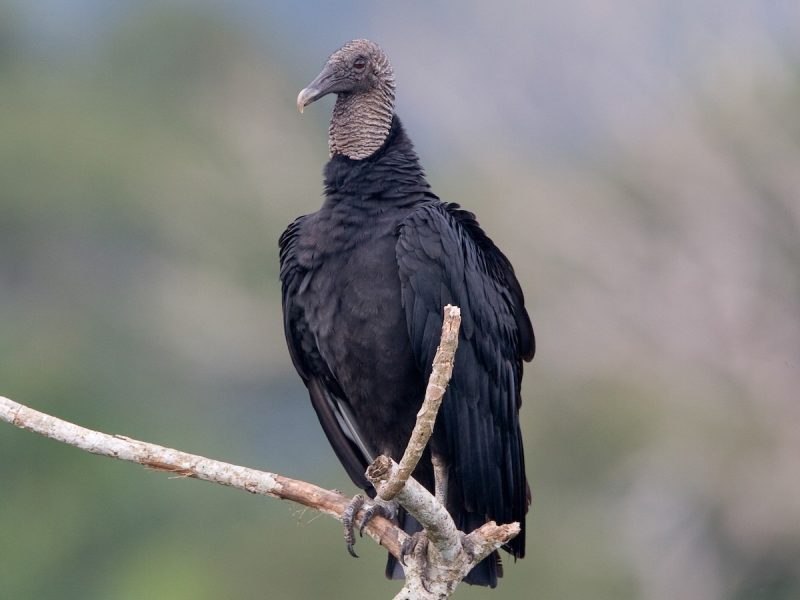
The Black Vulture is slightly smaller than the Turkey Vulture and has a bare black head with dark gray to black plumage. They are less graceful in flight but are often seen in flocks soaring with Turkey Vultures across Alabama. Their short tails and stiff wing tips create a slightly jagged silhouette.
Black Vultures are scavengers, feeding primarily on carrion. They are more aggressive than Turkey Vultures and sometimes harass other vultures or animals to access food. Their social behavior includes roosting and traveling in groups, which helps them locate food efficiently.
In Alabama, Black Vultures are permanent residents, favoring open fields, roadsides, and forest edges. Their boldness and communal habits make them highly visible, especially in rural areas.
Cooper’s Hawk
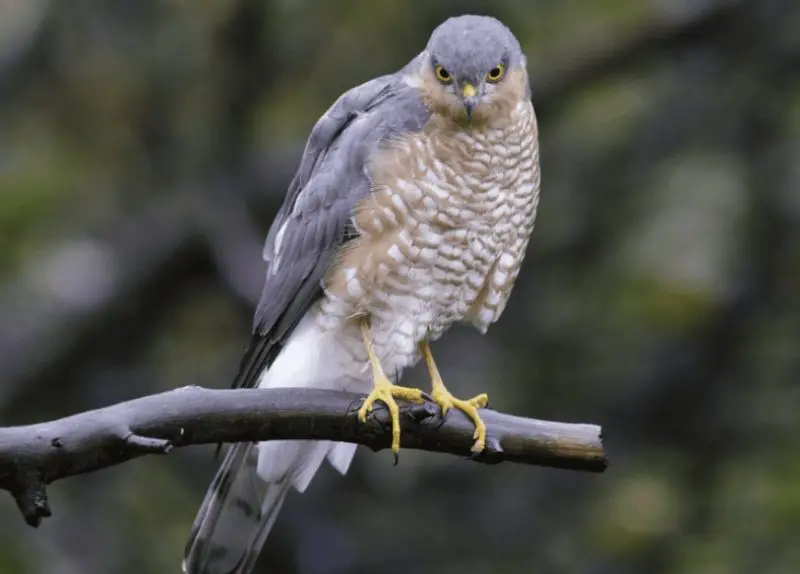
The Cooper’s Hawk is a medium-sized raptor with a rounded tail and short, broad wings, ideal for agile flight through forests. Adults have blue-gray upperparts and a reddish barred chest, while juveniles are brown with streaked underparts. These birds are stealthy predators in Alabama, often hunting smaller birds in suburban and forested areas.
Cooper’s Hawks are skilled hunters, relying on speed and surprise rather than soaring. They often perch quietly before dashing through dense trees to capture songbirds or small mammals. Their sharp talons and hooked bill make them effective predators.
In Alabama, they are year-round residents and can adapt to wooded suburbs as well as natural forests. Their elusive nature and hunting prowess make them a fascinating raptor to observe for bird enthusiasts.
Red-tailed Hawk
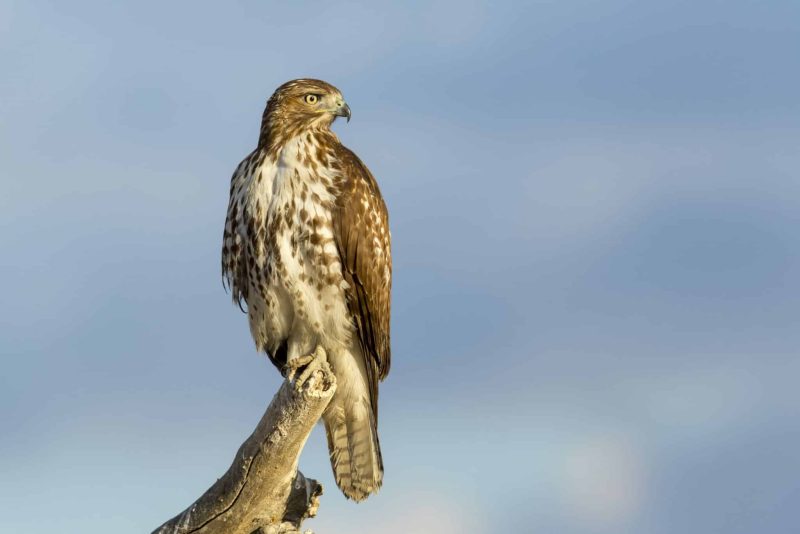
The Red-tailed Hawk is a large raptor easily recognized by its broad wings, short tail, and the distinctive reddish-brown coloration on the upper side of the tail. Its plumage can vary from dark brown to lighter shades, but the red tail is a reliable field mark in Alabama. These hawks are common throughout open fields, forests, and suburban areas.
Red-tailed Hawks are versatile hunters, preying on small mammals, birds, and reptiles. They often soar high in the sky to spot prey, then dive swiftly for capture. Their loud, descending “kee-eee-ar” call is familiar to many in Alabama, often heard before the bird is seen.
In Alabama, they are year-round residents, adapting well to urban and rural landscapes. Their striking presence in flight and commanding calls make them one of the most recognized raptors in the state.
Barred Owl
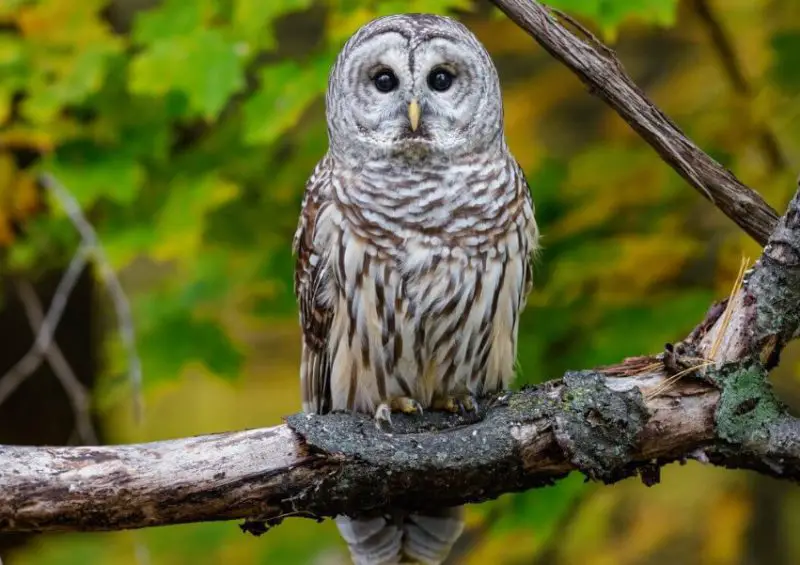
The Barred Owl is a medium to large owl with brown eyes, a rounded head, and no ear tufts. Its body is marked with horizontal barring on the chest and vertical streaks on the belly. This nocturnal predator is most often found in Alabama’s mature forests and swamps, where it blends seamlessly into tree trunks.
Barred Owls are known for their distinctive “Who cooks for you? Who cooks for you all?” call, which is often heard at dusk or during the night. They hunt small mammals, birds, amphibians, and insects, relying on stealth and silent flight to capture prey.
In Alabama, Barred Owls are non-migratory and occupy territories year-round. They prefer dense forests with water sources nearby, but they have also adapted to suburban woodlands. Their haunting calls and elusive nature make them one of the state’s most intriguing owls.
Great Horned Owl
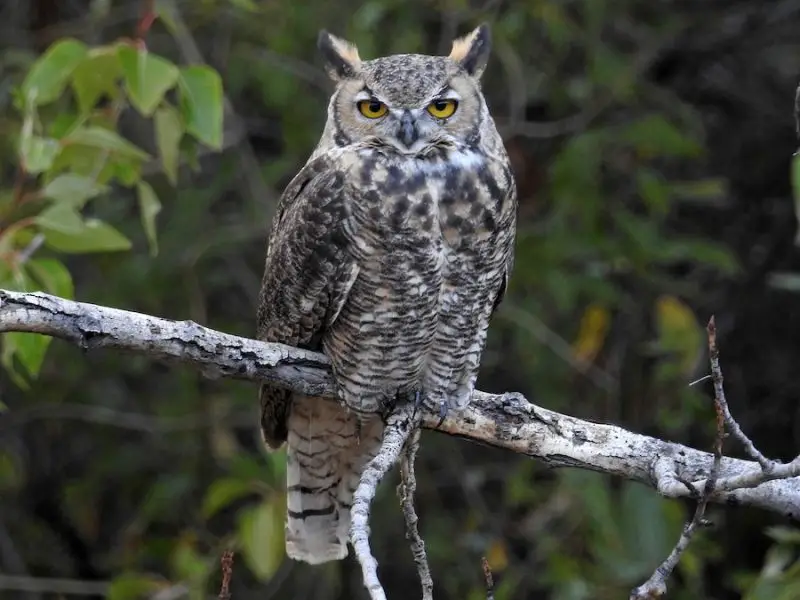
The Great Horned Owl is a large, powerful raptor with prominent ear tufts, a stocky build, and yellow eyes. Its plumage is mottled brown, gray, and white, providing excellent camouflage against tree bark. These owls are nocturnal hunters, widely distributed across Alabama in forests, swamps, and urban parks.
They are apex predators, feeding on mammals, birds, reptiles, and even other raptors. Great Horned Owls are known for their deep, hooting calls, which can carry for long distances. They often nest in abandoned nests of large birds or in tree cavities.
In Alabama, they are year-round residents and highly adaptable to different habitats. Their impressive size, formidable hunting skills, and haunting calls make them a captivating presence for birdwatchers.
Killdeer
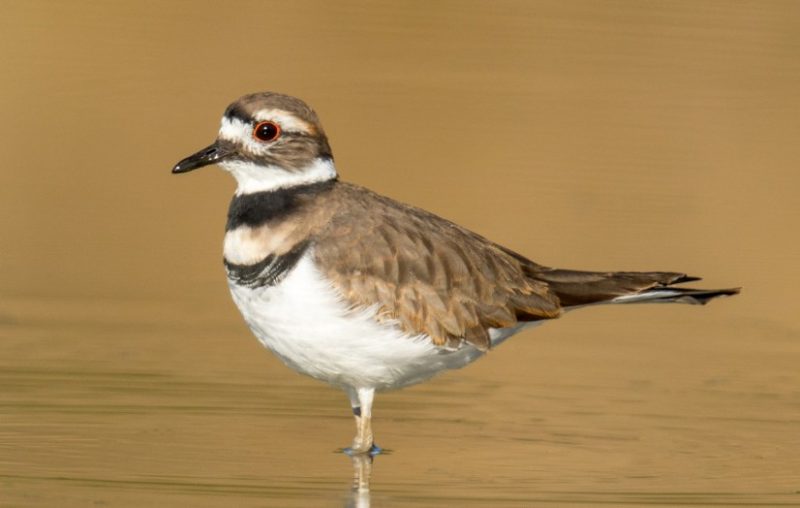
The Killdeer is a medium-sized plover with a brown back, white belly, and two distinctive black breast bands. Its long legs and energetic behavior make it easy to spot in Alabama’s open fields, mudflats, and grassy areas. This bird is known for its dramatic “broken-wing” distraction display used to protect nests.
Killdeers primarily feed on insects and small invertebrates, often foraging on the ground by sight. Their loud, high-pitched “kill-deer” call gives the species its common name and can be heard across fields and open areas.
In Alabama, Killdeers are mostly migratory, arriving in spring and leaving by late fall, though some remain year-round in milder regions. Their ground-nesting habits and bold displays make them a memorable sight in open habitats.
Eastern Meadowlark
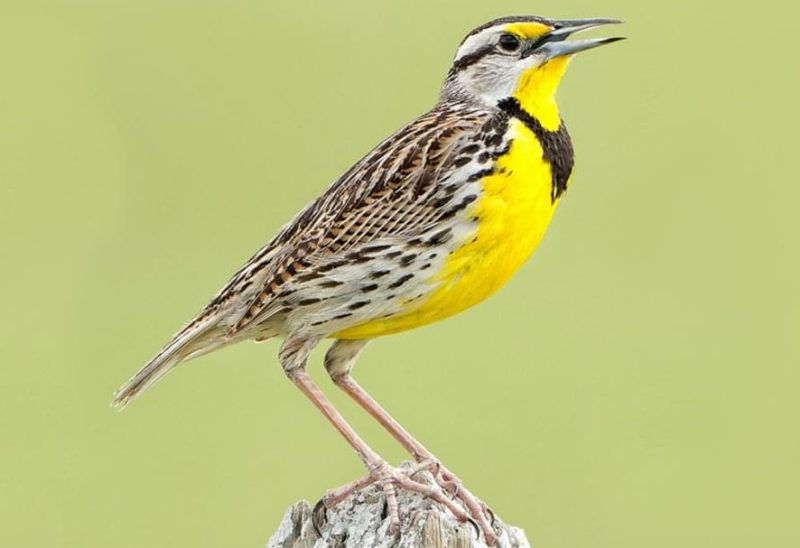
The Eastern Meadowlark is a medium-sized songbird with bright yellow underparts, a black “V” on its chest, and streaked brown back feathers. Its melodic, flute-like song is a hallmark of Alabama’s grasslands, pastures, and open fields.
They feed primarily on insects and seeds, using their strong bills to probe soil and vegetation. Eastern Meadowlarks are ground-nesting birds, often concealed in tall grasses or pastures. Their bold song helps establish territory and attract mates.
In Alabama, they are primarily residents in open habitats, although numbers may fluctuate seasonally with migration. Their bright coloring and cheerful song make them a standout species in the state’s meadows and farmland.
Northern Flicker
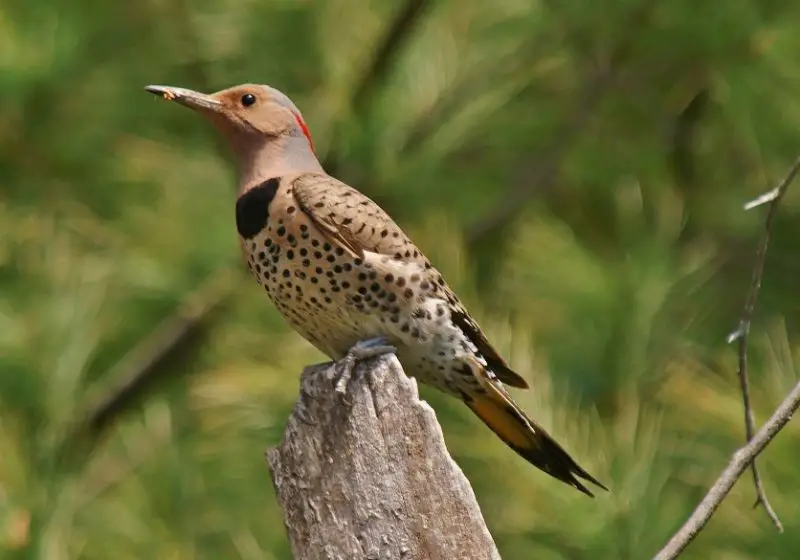
The Northern Flicker is a medium-sized woodpecker with a brownish body, black spots on the chest, and a white rump visible in flight. In Alabama, the “yellow-shafted” form is common, showing bright yellow feathers under the wings and tail. Unlike most woodpeckers, Flickers often feed on the ground, probing for ants and insects.
Their distinctive calls include a loud “wick-a-wick-a-wick” and a drumming pattern on trees or metal surfaces. Northern Flickers also excavate nest cavities in dead trees or wooden posts, which may later be used by other birds.
In Alabama, they are year-round residents, frequenting forests, woodland edges, and suburban yards. Their striking appearance, energetic foraging behavior, and loud calls make them a familiar and lively presence in many habitats.
Belted Kingfisher
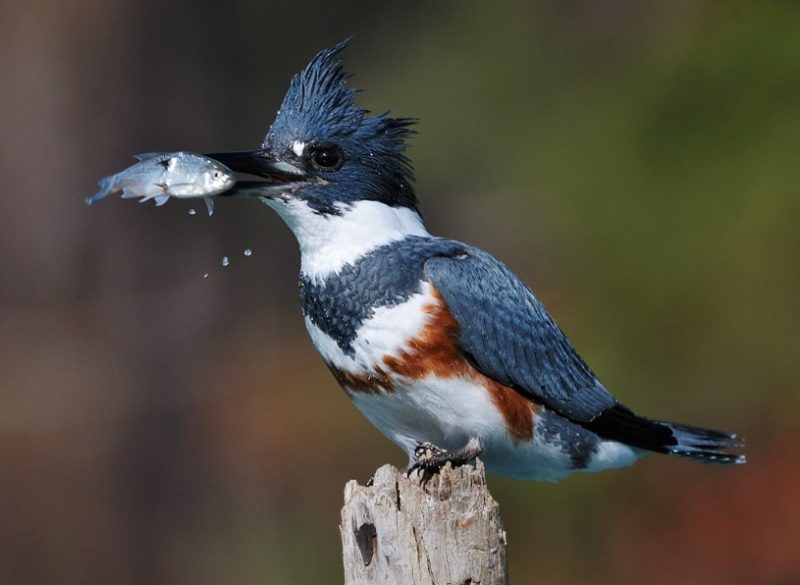
The Belted Kingfisher is a medium-sized bird with a large head, shaggy crest, and a long, sharp bill. Its slate-blue upperparts, white collar, and breast band—rust-colored in females—make it distinctive in Alabama. These birds are most often seen near rivers, lakes, and ponds, hovering or diving to catch fish.
Belted Kingfishers feed primarily on fish but also eat amphibians, crustaceans, and insects. Their loud, rattling call is a common sound along Alabama’s waterways, often heard before the bird is spotted. They perch on branches or posts, scanning the water for prey before plunging headfirst in a rapid dive.
In Alabama, they are year-round residents, occupying freshwater habitats from streams and ponds to larger rivers. Their bold fishing behavior and striking appearance make them a favorite among birdwatchers.
Best Time and Places to Observe Birds in Alabama
Birdwatching in Alabama can be enjoyed throughout the year, but certain seasons offer better opportunities for observation. Spring, from March to May, is the peak migration period when numerous songbirds, warblers, and flycatchers pass through the state. Birds are particularly active in the early morning, making dawn the ideal time for observation.
Summer, between June and August, is the breeding season for many resident birds such as Northern Cardinals, Blue Jays, and various woodpeckers. Observing nesting behavior and feeding activity during these months can be particularly engaging, especially in suburban gardens, forest edges, and parks.
Fall, from September to November, brings northern species moving south, including sparrows, swallows, and raptors. Cool, clear mornings during this season provide excellent visibility, making it easier to spot migratory flocks and raptors soaring over open fields.
Winter, from December to February, sees migratory species like White-throated Sparrows and American Goldfinches arriving. They often gather at feeders or open habitats, making them easier to spot. Winter is also ideal for observing resident species in less dense foliage.
Alabama’s diverse habitats offer numerous excellent birdwatching locations. The Huntsville Botanical Garden attracts songbirds, warblers, and woodpeckers in spring and summer. The Mobile-Tensaw Delta is ideal for waterfowl, herons, egrets, and other wading birds year-round. Dauphin Island serves as a key stopover for migratory shorebirds and warblers during spring and fall. Bankhead National Forest provides opportunities to see owls, hawks, and forest-dwelling songbirds.
Even local parks and backyards can be productive. Feeders attract cardinals, chickadees, finches, and woodpeckers, making urban birdwatching convenient. Early mornings and late afternoons are generally the most productive times for spotting active birds, while calm, clear days enhance visibility and photography opportunities.
FAQs about Common Birds in Alabama
What are some of the most common birds found in Alabama?
Alabama is home to a wide variety of common birds, including the Northern Cardinal, Blue Jay, American Robin, Eastern Bluebird, and Carolina Chickadee. These species are frequently seen in backyards, parks, and forests throughout the state and are recognized for their distinctive colors and songs.
Are Northern Cardinals year-round residents in Alabama?
Yes, Northern Cardinals are non-migratory and can be observed throughout the year. Males are bright red, while females display warm brown tones with hints of red. They are adaptable, frequenting gardens, woodlands, and urban areas.
When can I see migratory birds in Alabama?
Migratory birds typically pass through Alabama during spring (March to May) and fall (September to November). Songbirds, warblers, sparrows, and shorebirds use the state as a stopover, while some winter visitors, like White-throated Sparrows and American Goldfinches, arrive from northern regions.
Which habitats in Alabama attract the most bird species?
Diverse habitats support a variety of birds. Forests attract woodpeckers, owls, and chickadees. Wetlands and deltas, such as the Mobile-Tensaw Delta, host waterfowl, herons, and egrets. Open fields provide opportunities to see Eastern Meadowlarks and Red-winged Blackbirds, while suburban yards and feeders bring cardinals, finches, and chickadees close to humans.
Are there specific times of day that are best for spotting common birds?
Yes, early mornings and late afternoons are generally the most active periods for birds. During these times, they are busy feeding, singing, and defending territories. Calm and clear weather also enhances visibility and birdwatching experiences.
How can I attract common birds to my backyard in Alabama?
Using feeders with sunflower seeds, suet, or thistle (nyjer) seeds is very effective. Planting native shrubs and trees can provide shelter and nesting sites. Water sources like birdbaths or small ponds also encourage visits from both resident and migratory species.
Are there any rare or unusual birds I might see in Alabama?
While Alabama hosts many common birds, occasional sightings of less frequent species like the Purple Martin, Great Crested Flycatcher, or Pileated Woodpecker can occur. Coastal areas, wetlands, and protected forests are the best places for spotting these rarer visitors.

